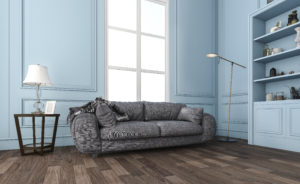Serving Charlotte, Monroe, Concord &
All Of Mecklenburg County
Menu
 If your floors have been devastated by water damage, it’s time to shop for an improvement. If there is a chance that this area will get soaked again, plan ahead by choosing more water resistant materials.
If your floors have been devastated by water damage, it’s time to shop for an improvement. If there is a chance that this area will get soaked again, plan ahead by choosing more water resistant materials.
The sky’s the limit when it comes to design choices. Many budget friendly products give the look of wood floors for areas of the home that might get wet. In general, inorganic materials are more waterproof but here are three more organic options:
Porcelain and ceramic tile provide the best defense against pooled water on floors. The entire piece is baked at super high heat and makes an impermeable barrier. While the tiles are solid, the grouted seams can leak; maintain a regular grout sealing schedule.
Many styles of vinyl flooring are relatively inexpensive and hold up well against household spills. Sheet vinyl is waterproof and usually has very few seams that allow water to penetrate to the subfloor. Waterproof core (WPC) vinyl plank flooring has improved immensely; it’s even more durable and can realistically mimic stone, wood and tile looks. Plus, it is softer to walk on. An extra benefit of vinyl planks is the ability to replace individual pieces without changing the entire floor.
Properly sealed concrete is an excellent choice for ground floors and basements. Many attractive treatments are available to keep it from looking like a parking lot: tinted, stained, polished or stamped surfaces.
Stone is stylish and very popular for bathroom installations. Stone tiles offer a timeless look and feel for bathrooms and can last a lifetime if properly maintained. Marble tile is sophisticated and beautiful with their own unique vein patterns and streaks of color.
Limestone is formed from sedimentary materials. Often featuring fossilized patterns, limestone’s color options are in the tan, gray, and white spectrum. Available in a range of textures, it can be honed to provide a smooth surface. Again, seal this porous material every few years for protection against moisture and liquids,
Travertine can be polished to a brilliant shine. Slate, on the other hand, is naturally slip resistant and retains heat easily– a great option for bathroom flooring for minimizing slips and keeping toes warm.
Don’t keep carpeted bathrooms and laundry rooms; it retains moisture and promotes mold growth. Convert to a solid surface floor, then soften with washable bath-mats on a latex backing.
Solid hardwood flooring, particularly parquet or tongue-and-groove, is not recommended for damp areas in the home. Since wood is organic, excess water will be absorbed into the planks themselves. Water damaged floors are a) difficult to refinish and b) provide a great place for mold to grow.
Let Restoration 1 be your trusted partner. Having fabulous floors after water damage will require 100% repair of the original problem before installing. Restoration 1 provides certified water damage restoration services in Monroe and Greater Charlotte.
At Restoration 1, the team designs a plan for your home to ensure your property is 100% dry by using the best equipment in the industry.